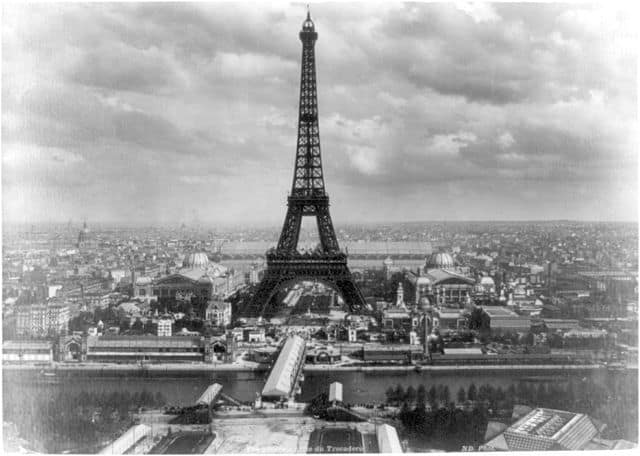With France being the number one visited place in the world, it’s likely that you are one of the millions of people enchanted by this beautiful country. I know that the minute I stepped foot here for the first time there was no turning back!
Well, it’s been a pretty interesting ride, if you know anything about it’s history! If you don’t know much, keep reading – I’ve got the 10 most interesting facts about French History coming right up!
1 It’s been a while: France is one of the world’s oldest nations
France can date it’s history all the way back to 600 BC with the ancient Gallic Celtic tribes. These tribes settled into the area of Europe that we now know as France, and you know what they say…the rest is history!
Fast forward a few hundred years, where the group of people living in the territory are called the pagan Franks. Their leader, Clovis I, becomes leader of the tribes, and the territory is thus called Francia, or, “Land of the Franks”. Clovis I was the first to unite all of the tribes of the Franks under one nation and ruler, and he also converted to Catholicism. While it will take several hundred more years to become the France we all know and love today, Clovis I is considered to be the first king of what would “become” France.
2 You thought Stonehenge was old?! You must have never heard of Carnac!
The famed ancient rock formation of Stonehenge in England has been the source of a collective “what?!” for thousands of years. But, what if I told you that Stonehenge was predated by something similar in northern France by 100 years?That’s right: Carnac is located in Brittany, France!
Carnac and Stonehenge are what scientists refer to as megalithic sites. This simply means they are groups of large stones that have been used to construct a monument.
Like Stonehenge, there are many theories as to how the rocks in Carnac got there and what they were used for. Christians say that the rocks were originally pagan soldiers that Pope Cornelius turned to stone. Local legend states that they were Roman soldiers that the famed wizard Merlin turned to stone, and that is why they stand up so straight!
3 It wasn’t always Rome: the papal headquarters was located in France for 70 years
Between 1309 and 1378, French popes ruled the Roman Catholic Church out of a palace in Avignon.
With Italy in unrest and wars looming left and right, French King Philippe IV le Bel (Phillip the Handsome) made the political move to invite Pope Clement V to set up house in France. The move ended up being a pretty smart one of the part of King Philippe, as for the next 70 years the pope was French! If you know anything about how authoritative the Church was at the time, this basically ensured France’s influence over the world. Talk about a power move.
4 Long Live the King…or not

The Storming of the Bastille on 14 July 1789, ca. 1793 by Charles Thévenin, courtesy of The Metropolitan Museum of Art – WikiCommons
If you have visited Paris, you have most likely visited the Place de la Bastille, where the ancient Bastille Prison was once located. The Place is pretty impressive to this day – there are some places in Paris that I swear you can actually feel the history vibrating around you! It’s one of my favorite parts of living in this beautiful city.
Do you know the story of when French peasants stormed the place and stole the monarchy’s gun powder? And how this marked the beginning of what is known as the French Revolution?!
For the revolutionary forces, the prison symbolised the King and Queen’s abuse of power. If you’re having trouble remembering why France revolted against the rulers, to put it in it’s most basic terms: the citizens of France were starving, and the monarchs were living like kings and queens, quite literally! There needed to be a change, and for the French people, a revolution was the only option. This attack on the Bastille prison was just the start of the bloody revolt.
5 La Terreur
Now you know how the French Revolution began, let’s move onto the horrors that occurred. Although the revolutionaries had good intentions, their plans quickly spiralled out of control, beginning a period in French history known as the Reign of Terror, or La Terreur in French.
The people of France were so livid with the state of their country as a result of the lavish and selfish lives of their rulers, that they felt it necessary to get revenge. Enter the guillotine, invented in 1789 by Doctor Joseph-Ignace Guillotine as a simple and quick way to kill enemies of the revolution.
After the fall of the monarchy, the Committee of Public Safety was introduced in order to run things. The committee was headed by Maximilien Robespierre, one of the many men responsible for beginning the Reign of Terror. Under his rule, at least 17,000 were killed using the guillotine. The Place de La Concorde is where many of the beheadings occurred, which is hard to imagine, as today it is one of the most beautiful places in Paris. Situated at the base of the Champs Elysées, there are views of the Arc de Triomphe, the Eiffel Tower, the Louvre, the Tuileries gardens, and the impressive obelisk in the center of the square. My very first Parisian apartment was located just next door, and I remember being taken back by all of the sites you can see in one place. This is another one of those places in Paris where you can really feel the history surrounding you!
How could Robespierre decide that this beautiful place should be an excellent spot to commit so much violence?! If it seems like after the Revolution the French had traded one crazy king for an even crazier dictator, it’s because that’s what happened.
6 King for the day, or at least 20 minutes
And the award for the shortest ever reign of France goes to…Louis-Antoine Duke of Angoulême!
After the bloody French Revolution ended, it’s hard to believe that the country then reverted back to the monarchy, but it did, at least for a little while longer. After the Reign of Terror, the French First Republic was created, but just 12 years later it’s leader, Napoléon Bonaparte, dubbed himself the Emperor of France. Fast forward about 20 years, and France is headed by the House of Bourbon, and the people of France are starting to become fed up with the monarchy again.
King Charles X is ruler during the July Revolution of 1830, when he renounces his power. His son Louis-Antoine quickly rushes to take the throne, but that didn’t last long…not even 30 minutes! Taking a cue from dear old dad, Louis-Antoine realized it probably wasn’t such a good idea to be king during a revolution…he had the right idea.
7 Paris gets a makeover

Paris before Haussmann. Panorama de Paris – Pris de la tour Saint Jacques, ca. 1865 by Charles Soulier courtesy of The United States Library of Congress – WikiCommons
If I walk down one of the cobblestone backstreets near l’Opera for example, it is hard to imagine that mud, human excrements, trash, and even dead bodies would have been the obstacles in my way at this time. In an attempt to clean up and modernize Paris, architect Baron Haussmann remade the city under the orders of Napoléon III.
The upheaval was controversial as thousands of Parisians were relocated against their will, as Haussmann added arrondissements, wide boulevards, and green spaces in the city. That being said, with populations skyrocketing from 785,000 to 1 million in just 20 years, a change was necessary.
Although Parisians were initially not okay with the change, in the end, there really wasn’t much to complain about with the new open spaces, fresh air, and decrease in disease! I know I personally sooo appreciate all of the green spaces throughout the city!
8 The Eiffel Tower should have come down

Eiffel Tower at Exposition Universelle, Paris, 1889 by Neurdein courtesy of The United States Library of Congress – WikiCommons
I know what you’re thinking…a Paris without the Eiffel Tower?! Non! Like many amongst you, the tower was definitely first on my list of things to do when I first got here. In fact, yes, the Eiffel Tower was actually supposed to be a temporary exhibit in the 1889 World’s Fair to celebrate the 100th anniversary of the French Revolution. World’s Fairs were held throughout the ages (notably in Paris!) as a way for nations to show off their latest inventions, architectural feats, and cultures. You may have heard of the famous Fair of 1937 in Paris dedicated to Art and Technology in Modern Life that featured pavillons by Nazi Germany and Soviet Union. This was just a few years before the start of WWII, and the relationships between these 2 nations and France would change forever! Although the expositions may seem like a thing of the past, the most recent occurred just last year in Kazakhstan.
What prevented the tower from falling down? France decided to use the antenna that was built on top of the tower to conduct wireless signals. It looks like the radio saved the day, as the Eiffel Tower is considered to be the most recognizable monument in the world!
Something else that is pretty interesting to mention about the Iron Lady? Parisians actually hated the tower when it was first erected! Citizens at the time were quoted as saying that the “big black smokestack” would ruin the aesthetic of the city. After living here for a while now, I’m not that surprised (and all of my French friends will readily admit to this!) – Parisians love having something to complain about!
9 If you think the word camouflage looks French…it’s because it is
The French verb camoufler means ‘to make oneself up for the stage’. The battlefield may not be the stage, but putting on a uniform in order to hide from the enemy definitely involves some preparation!
Up until the First World War, military uniforms tended to be brightly colored. After figuring out that this probably wasn’t the best idea to hide if you want to be discreet, the French Army Was the first to create a specific unit called camoufleurs, soldiers specialised in camouflage! They started with painting trucks, vans, and weapons in inconspicuous colors in order to blend in better to their surroundings, and eventually trained other units to be as well versed in the art as they were.
10 They shoot like pigs
Those were the words uttered by the 18th French President Charles de Gaulle after one of many unsuccessful assassination attempts on his life. President de Gaulle was responsible for leading the French Resistance movement against the Nazi powers during WWII, and was also asked to rewrite the French constitution after the foundation of the Fifth Republic. He was then elected president in 1959, and remained in office until 1969.
Over the course of his presidency, de Gaulle survived 32 assassination attempts from many different groups. This included Jean Bastien-Thiry, who was unhappy that de Gaulle had accepted the Algerian independence, and even an attempt by the CIA to poison him.
President Charles de Gaulle is actually in the Guinness Book of World Records as surviving the most assassination attempts in the world! I knew there had to be a good reason that there are so many things in Paris that bear his name!
I hope you’ve enjoyed this brief history lesson on France! Did you know that 80 million tourists visit France each year to learn more? Take my advice…book those plane tickets, and become one of the 80 million – you won’t regret it!
Planning a trip to Paris ? Get ready !
These are Amazon’s best-selling travel products that you may need for coming to Paris.
Bookstore
- The best travel book : Rick Steves – Paris 2023 – Learn more here
- Fodor’s Paris 2024 – Learn more here
Travel Gear
- Venture Pal Lightweight Backpack – Learn more here
- Samsonite Winfield 2 28″ Luggage – Learn more here
- Swig Savvy’s Stainless Steel Insulated Water Bottle – Learn more here
Check Amazon’s best-seller list for the most popular travel accessories. We sometimes read this list just to find out what new travel products people are buying.

















